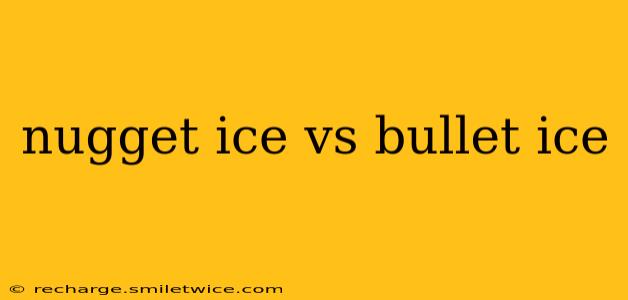Choosing between nugget ice and bullet ice can feel like choosing between two delicious scoops of ice cream – both are refreshing, but each offers a unique experience. This comprehensive guide dives deep into the differences between these two popular ice types, helping you determine which reigns supreme for your needs. We'll explore their textures, melting rates, uses, and even the machines that create them.
What is Nugget Ice?
Nugget ice, also known as "chewable ice" or "Sonic ice," is characterized by its small, porous, and somewhat soft, almost chewy texture. Its irregular, nugget-like shape is what gives it its name. This texture is a key factor in its popularity, leading many to prefer it over traditional ice cubes or even the sharper bullet ice.
What is Bullet Ice?
Bullet ice, also called "pebble ice" or "ice pellets," is a small, cylindrical ice shape. It's denser and harder than nugget ice, leading to a faster, more intense chill. The smoother surface area means less surface for melting, contributing to its longer lifespan compared to its nugget counterpart.
Nugget Ice vs. Bullet Ice: A Head-to-Head Comparison
| Feature | Nugget Ice | Bullet Ice |
|---|---|---|
| Texture | Soft, porous, chewy | Hard, dense, smooth |
| Shape | Irregular, nugget-like | Small cylinders, "bullet" shaped |
| Melting Rate | Melts relatively quickly | Melts relatively slowly |
| Chill Intensity | Gentle, longer-lasting refreshment | Intense, quicker cooling effect |
| Best Uses | Cocktails, smoothies, chewing, kids | Chilled drinks, water bottles, ice chests |
| Machine Cost | Generally more expensive machines | Typically less expensive machines |
What are the differences in ice maker machines?
The machines that produce nugget ice and bullet ice differ significantly in their internal mechanisms. Nugget ice machines utilize a unique process involving a rotating drum or auger that produces the characteristic porous texture. Bullet ice machines generally employ a different process of freezing water in a continuous cycle of small chambers, resulting in the consistent cylinder shape. The price point often reflects the complexity of the nugget ice machine's engineering.
How does the shape affect the melting rate?
The porous nature of nugget ice provides a larger surface area, leading to faster melting. The smooth, dense surface of bullet ice offers less surface area, therefore melting more slowly. This is why bullet ice is often preferred for situations requiring long-lasting ice, such as coolers.
Which type of ice is best for different drinks?
Nugget ice excels in applications where a softer, more pleasant mouthfeel is desirable. It's ideal for:
- Cocktails: The slower melt rate allows for a longer period of time before the drink gets diluted.
- Smoothies: The texture blends well and doesn't overpower the other ingredients.
- Kids' drinks: The chewable aspect makes it fun and safe for children.
Bullet ice is best for situations needing fast cooling and a longer-lasting chill:
- Water bottles: Maintains coolness over extended periods.
- Ice chests: Keeps contents cold for longer.
- Drinks that require a quick chill: Bullet ice will quickly cool your beverage.
Which type of ice is better?
Ultimately, the "better" ice type depends entirely on your personal preference and intended use. There's no single winner; both nugget and bullet ice serve different purposes admirably. Consider the factors discussed above to make the best choice for your individual needs.
